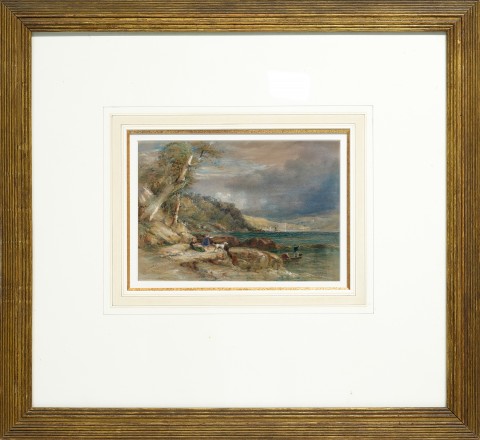ELIZABETH BAY, SYDNEY, c.1840
CONRAD MARTENS
watercolour on paper
18.0 x 25.5 cm
signed lower left: C. Martens
inscribed with title on typed label verso: ELIZABETH BAY, SYDNEY
Barry Taffs, Sydney (label attached verso)
Sotheby’s, Melbourne, 16 April 1985, lot 48
Masterpiece Fine Art Gallery and Antiques, Hobart (label attached verso)
Private collection, Tasmania
Christie’s, Sydney, 14 August 1994, lot 78
Private collection, Melbourne
Private collection, Melbourne, acquired from the above
Elizabeth Bay, 1838, watercolour, 44.4 x 62.9 cm, in the collection of the Art Gallery of New South Wales, Sydney
Elizabeth Bay House, 1838, watercolour, 19.0 x 27.3 cm, private collection, illus. in Dundas, D., The Art of Conrad Martens, Macmillan, Melbourne, 1979, p. 62
Elizabeth Bay and Elizabeth Bay House, 1839, watercolour, 44.8 x 65.4 cm, in the collection of the National Gallery of Victoria, Melbourne
View of Elizabeth Bay, Elizabeth Bay House and Sydney from Darling Point, c.1845, watercolour with pencil with gum Arabic on paper, 31.0 x 50.0 cm, private collection
From Darling Point looking towards Elizabeth Bay House and the city, 1847, watercolour, 29.4 x 43.5 cm, in the collection of Elizabeth Bay House, Sydney Living Museums, Sydney
At sixteen years of age, Conrad Martens, following in the path of his elder brothers Henry and John, began his artistic studies under the landscape watercolourist Copley Fielding (1787 – 1855). However, it wasn’t until he left England in 1832, joining the well-worn path of other young English and European artists who travelled the world, that his notable journey began as he embarked on an extended trip to the East Indies. Upon arriving in Rio de Janeiro in 1833, Martens’ plans unexpectedly changed, and he left the Hyacinth, later transferring to the HMS Beagle under Captain Robert FitzRoy where he replaced the ill Augustus Earle as the ship’s artist. Here, Martens worked alongside a young Charles Darwin whose scientific studies and naturalist observations deeply influenced Martens’ artistic practice. Martens’ invaluable time on HMS Beagle formed the platform for his mature artistic style, wherein he married his technical artistic skills with a more empirical approach.
In 1835, Conrad Martens arrived in Sydney, delighting in the various aspects and vantage points of the Sydney Harbour. He established a studio in Pitt street and in a short time, his work found favour with the wealthy elites anxious to display their newfound status. Sydney Harbour with its steep and verdant native undergrowth slopping down to a glistening sea offered endless opportunities, both intimate and panoramic, to depict picturesque scenes and the colony’s newfound prosperity. Most of Martens’ watercolours and oils were commissions incorporating not only expansive harbour views, but also the Illawarra and Blue Mountains.
In Elizabeth Bay, Sydney, c.1840 we see an idyllic and genial domestic scene. A woman seated on rocky platform, watching a child who appears to be pointing to a nearby fisherman casting a line from a small vessel nearby. The figures enveloped by a ragged shoreline with Elizabeth Bay House in the distance are set against a foreboding dark sky. Throughout his career, Martens’ watercolours celebrated topographical accuracy over imagination, and his skill was to incorporate minute details within often expansive Claudian-influenced panoramas within the observed landscape, native flora and climatic conditions.


